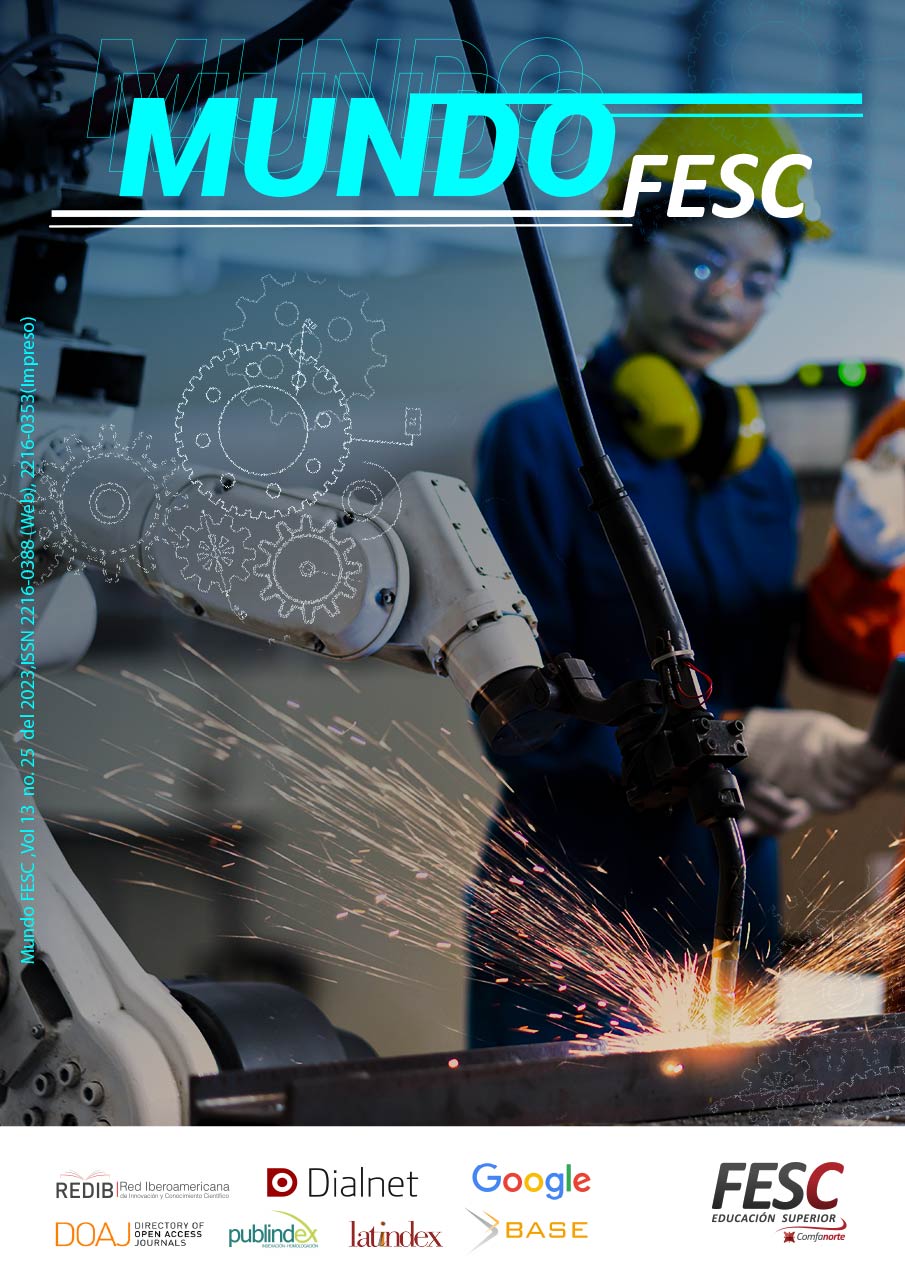Tendencia de la Industria 4.0 comparado con Industria 5.0
DOI:
https://doi.org/10.61799/2216-0388.1248Palabras clave:
Cobots, Industria 4.0, Industria 5.0, Inteligencia artificial, Sociedad 5.0Resumen
El presente estudio aborda una exploración de literatura de industria 4.0 comparada con industria 5.0. De tal modo que el estudio realiza una exploración de la marcha del progreso industrial marcada por la aparición de tecnologías disruptivas que originan revoluciones con un importante impacto social y económico. De manera similar al análisis de cómo en la Industria 4.0 los humanos utilizan la tecnología para monopolizar la generación de conocimiento e inteligencia, la Industria 5.0 pretende generar este conocimiento e inteligencia a partir de las propias máquinas. La nueva etapa en la industria sugiere que los robots colaborativos (cobots) se harán más frecuentes en los próximos años, junto con el despliegue de software inteligente (bots), lo que allanará el camino para un nuevo concepto de desarrollo económico e industrial, con el retorno del hombre al proceso y al modelo productivo, la relación integradora entre el hombre y la tecnología adquiere un nuevo significado. Finalmente, este artículo documenta la revisión de la literatura que fueron publicados en el tema de la Industria 4.0 y la Industria 5.0, los artículos fueron revisados e investigados en diferentes bases de datos y en revistas de alto rango con el fin de obtener la mejor comprensión de ambas industrias.
Descargas
Referencias
P. Coelho, C. Bessa, J. Landeck, and C. Silva, “Industry 5.0: The Arising of a Concept,” Procedia Comput. Sci., vol. 217, pp. 1137–1144, Jan. 2023. doi: 10.1016/j.procs.2022.12.312 DOI: https://doi.org/10.1016/j.procs.2022.12.312
K. Schwab, “La Cuarta Revolución Industrial,” Futuro Hoy, vol. 1, no. 1, Art. no. 1, Dec. 2020. doi: 10.52749/fh.v1i1.1
R. Albrieu et al., “Travesía 4.0: Hacia la transformación industrial argentina,” Jun. 2019, doi: 10.18235/0001731 DOI: https://doi.org/10.18235/0001731
J. Leng et al., “Industry 5.0: Prospect and retrospect,” J. Manuf. Syst., vol. 65, pp. 279–295, Oct. 2022. doi: 10.1016/j.jmsy.2022.09.017 DOI: https://doi.org/10.1016/j.jmsy.2022.09.017
S. Vijaykumar, S. G. Saravanakumar, and M. Balamurugan, “Unique Sense: Smart Computing Prototype for Industry 4.0 Revolution with IOT and Bigdata Implementation Model,” Indian J. Sci. Technol., vol. 8, no. 35, Dec. 2015. doi: 10.17485/ijst/2015/v8i35/86698 DOI: https://doi.org/10.17485/ijst/2015/v8i35/86698
H. Ning and H. Liu, “Cyber-physical-social-thinking space based science and technology framework for the Internet of Things.,” Sci China Inf Sci, vol. 58, no. 3, pp. 1–19, 2015 DOI: https://doi.org/10.1007/s11432-014-5209-2
M. Avendaño and L. Taiz, “Industria 5.0: ¿Vuelve el hombre al centro de los procesos de producción?,” bachelorThesis, Universidad EAFIT, 2019. [En línea].Disponible en: http://repository.eafit.edu.co/handle/10784/15195
K. A. Demir, G. Döven, and B. Sezen, “Industry 5.0 and Human-Robot Co-working,” Procedia Comput. Sci., vol. 158, pp. 688–695, Jan. 2019. doi: 10.1016/j.procs.2019.09.104 DOI: https://doi.org/10.1016/j.procs.2019.09.104
F. Strozzi, C. Colicchia, A. Creazza, and C. Noè, “Literature review on the ‘Smart Factory’ concept using bibliometric tools,” Int. J. Prod. Res., vol. 55, no. 22, pp. 6572–6591, Nov. 2017. doi: 10.1080/00207543.2017.1326643 DOI: https://doi.org/10.1080/00207543.2017.1326643
F. Mosconi, The New European Industrial Policy: Global Competitiveness and the Manufacturing Renaissance. Routledge, 2015 DOI: https://doi.org/10.4324/9781315761756
X. Xu, Y. Lu, B. Vogel-Heuser, and L. Wang, “Industry 4.0 and Industry 5.0—Inception, conception and perception,” J. Manuf. Syst., vol. 61, pp. 530–535, Oct. 2021. doi: 10.1016/j.jmsy.2021.10.006 DOI: https://doi.org/10.1016/j.jmsy.2021.10.006
S. Grabowska, S. Saniuk, and B. Gajdzik, “Industry 5.0: improving humanization and sustainability of Industry 4.0,” Scientometrics, vol. 127, no. 6, pp. 3117–3144, Jun. 2022. doi: 10.1007/s11192-022-04370-1 DOI: https://doi.org/10.1007/s11192-022-04370-1
F. Aslam, W. Aimin, M. Li, and K. Ur Rehman, “Innovation in the Era of IoT and Industry 5.0: Absolute Innovation Management (AIM) Framework,” Information, vol. 11, no. 2, Art. no. 2, Feb. 2020, doi: 10.3390/info11020124 DOI: https://doi.org/10.3390/info11020124
M. C. Zizic, M. Mladineo, N. Gjeldum, and L. Celent, “From Industry 4.0 towards Industry 5.0: A Review and Analysis of Paradigm Shift for the People, Organization and Technology,” Energies, vol. 15, no. 14, Art. no. 14, Jan. 2022. doi: 10.3390/en15145221 DOI: https://doi.org/10.3390/en15145221
L. Pérez-Domínguez, J. L. Macías-García, K. Y. Sánchez-Mojica, y D. Luviano-Cruz, “Comparación Método multi-criterio TOPSIS y MOORA para la optimización de un proceso de inyección de plástico”, Mundo Fesc, vol. 7, no. 14, pp. 98–105, jul. 2017
J. Liu, A. T. Gaynor, S. Chen, Z. Kang, K. Suresh, A. Takezawa, “To Current and future trends in topology optimization for additive manufacturing”, Structural and multidisciplinary optimization, vol. 57, no. 6, pp. 2457-2483, 2018 DOI: https://doi.org/10.1007/s00158-018-1994-3
H. Cañas, J. Mula, M. Díaz-Madroñero, and F. Campuzano-Bolarín, “Implementing Industry 4.0 principles,” Comput. Ind. Eng., vol. 158, p. 107379, Aug. 2021, doi: 10.1016/j.cie.2021.107379 DOI: https://doi.org/10.1016/j.cie.2021.107379
Y. G. . Chavez-Hernandez, L. A. . Perez-Dominguez, D. . Luviano-Cruz, I. J. . Pérez-Olguín, y K. Y. Sánchez-Mojica, “Flujo de operaciones en una celda de manufactura en las nuevas tecnologías”, reflexiones contables, vol. 5, no. 1, pp. 22–34, ene. 2022 DOI: https://doi.org/10.22463/26655543.3555
J. Wan, H. Cai, and K. Zhou, “Industrie 4.0: Enabling technologies,” in Proceedings of 2015 International Conference on Intelligent Computing and Internet of Things, Jan. 2015, pp. 135–140. doi: 10.1109/ICAIOT.2015.7111555 DOI: https://doi.org/10.1109/ICAIOT.2015.7111555
P. K. R. Maddikunta et al., “Industry 5.0: A survey on enabling technologies and potential applications,” J. Ind. Inf. Integr., vol. 26, p. 100257, Mar. 2022, doi: 10.1016/j.jii.2021.100257 DOI: https://doi.org/10.1016/j.jii.2021.100257
M. M. Nair, A. K. Tyagi & N. Sreenath, The future with industry 4.0 at the core of society 5.0: Open issues, future opportunities and challenges. In 2021 international conference on computer communication and informatics (ICCCI) (pp. 1-7). IEEE, 2021 DOI: https://doi.org/10.1109/ICCCI50826.2021.9402498
M. Doyle-Kent, “Industry 5.0: Is the Manufacturing Industry on the Cusp of a New Revolution?,” in Proceedings of the International Symposium for Production Research 2019, in Lecture Notes in Mechanical Engineering. Springer International Publishing, 2020, pp. 432–441. doi: https://doi.org/10.1007/978-3-030-31343-2_38 DOI: https://doi.org/10.1007/978-3-030-31343-2_38
M. Javaid and A. Haleem, “Critical Components of Industry 5.0 Towards a Successful Adoption in the Field of Manufacturing”, Journal of Industrial Integration and Management”, vol. 05, no. 03, pp. 327-348, 2020 DOI: https://doi.org/10.1142/S2424862220500141
D. Paschek, A. Mocan, and A. Draghici, “INDUSTRY 5.0 – THE EXPECTED IMPACT OF NEXT INDUSTRIAL REVOLUTION”, Thriving on Future Education, Industry, Business and Society; Proceedings of the MakeLearn and TIIM International Conference 2019
Publicado
Número
Sección
Licencia

Esta obra está bajo una licencia internacional Creative Commons Atribución-NoComercial 4.0.






